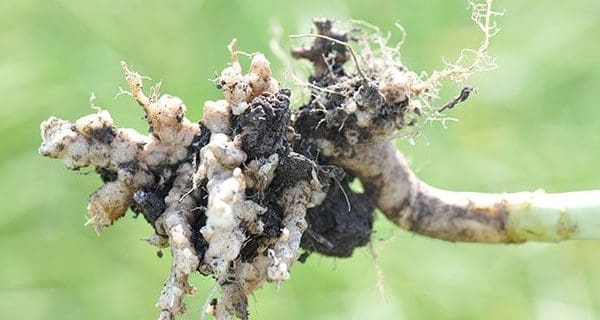Over the past year, we’ve been hearing the term “biosecurity” in regard to various pests in the agriculture industry. Agricultural biosecurity helps us protect crop and livestock systems against threats to our production from diseases, insect pests and invasive species such as weeds.

Kaeley Kindrachuk
Lately, we’ve been hearing more about biosecurity, specifically for clubroot. In 2017, clubroot was positively identified and confirmed in less than 10 commercial canola fields in Saskatchewan in Crop Districts 9A and 9B. This disease is not new to Western Canada, as some Alberta and Manitoba producers have been managing it on their farms for several years now.
Clubroot is a soil-borne disease affecting cruciferous crops like canola, mustard and camelina and weeds like shepherd’s purse, wild mustard, flixweed and stinkweed. It reduces yield by restricting the plants ability to obtain water and nutrients in the soil. Clubroot resting spores are long lived (up to 20 years) so complete eradication is unlikely, but we can and should take a proactive approach to managing it.
When we discuss biosecurity, there are a few different things we can do depending on our level of risk. Clubroot is spread by the movement of soil, so minimizing soil movement is one of the first steps to preventing the spread of the disease.
[emember_protected for=”2″ custom_msg=’For more on this story, please see the Feb. 2 print edition of The Cross Roads.’]
The level of risk for each field will depend on the level of activity. Equipment is the biggest risk as large amounts of soil can be moved, sometimes over a great distance and soil can also be spread by foot and animal traffic.
The risk is increased in wet conditions as it becomes more difficult to clean off equipment and footwear. Risk of spread from dust and water erosion will depend on whether the soil is spread a long distance or not. A lower risk is the spread through seed as there is limited soil on the seed, and it can be further reduced by seed cleaning and treatments.
The level of sanitation used on a farm will depend on the level of risk. There are three levels of sanitation that we use: a rough clean will involve scraping, brushing or blowing bulk soil and crop debris off of yourself or equipment, a fine clean will use pressure washing, scrubbing or compressed air to remove remaining residues, and the last and highest level of sanitation is applying a disinfectant for 30 minutes.
For most producers, the highest level of sanitation is not practical, so removing as much soil as possible in dry field conditions is advised. If clubroot is present in at least one field, work is done on multiple farms, the field conditions are wet and equipment comes from clubroot infected areas, the risk for disease spread is increased and higher levels of sanitation should be used.
To hear more about managing clubroot, biosecurity and sanitation, plan to attend a Top Notch Farming meeting closest to you. The meetings will be held Feb. 13, 14 and 15 in Melfort, Humboldt and Davidson respectively. Dr. Barbara Ziesman from Saskatchewan Agriculture will be speaking about clubroot in Saskatchewan at each of these meetings. In addition, attendees will also hear about grain quality from Rex Newkirk; phosphorus and sulphur fertilization from Dr. Jeff Schoenau in Humboldt and Davidson; and cutworms, flea beetles and beneficial insects from Dr. Tyler Wist.
For flax producers, Jessica Pratchler will talk about flax agronomy. To round out the day, there will be a market outlook given by Dustin Gabor of Grain Shark and Megan Madden will advise producers on how to “turn their tweets into bushels.” There will be CEU credits available for agrologists.
To register for this meeting, visit www.saskcanola.com or call 1-877-241-7044 by February 7. To see a detailed agenda, please contact your nearest Regional Crops Specialist.

